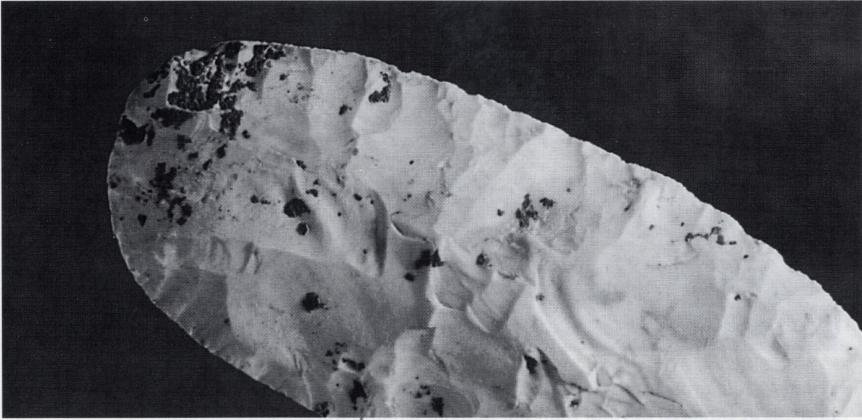by John F. Berner, EIC
Originally Published in the Central States Archaeological Journal, Vol.53, No.2, pg.59
Let’s address this title in a little more depth. Several years ago a collector friend advised me that you could advertise artifacts as guaranteed “Authentic” and yet offer replicas! I queried his statement and he said all “authentic” means is just that! He went on to say that to correct the message should have said “authentic prehistoric North American artifacts!” But wouldn’t that be much of a mouthful?
So what to look for on “authentic ancient prehistoric North American artifacts” is what we will proceed to discuss and talk about right now.
The flint biface below is a good example to start. It has “ferric oxide” deposits on the both faces. These minute deposits are result of minerals in the earth itself. After thousands of years having been buried in the soil, these particles which some experts describe as post depositional mineralization; subtly attach themselves to the host projectile.
Real patination/mineralization cannot be easily removed. False patination which can simulate this chemical reaction can often be flicked off the host projectile with a fingernail. Modern agers have occasionally removed ferric oxide deposits and reglued them to the surface of replicas. And under strong magnification the glue residue will show prominently as little shiny areas surrounding the deposits.
Who would have thought that someone would go to such extremes just to make a more convincing argument on the authenticity of an artifact? But such tactics are not limited to artifact preservation; coins, stamps, weapons and antique furniture have similar plagues.

This close-up photo shows us an example of heavily patinated Crescent chert found in St.Clair County, Illinois. Notice that many particles of the deposit feature halo type stains.

Not all forms of ferric oxide (oxide of iron, rust) result from the mineralization in the earth. Some deposits are from contact with farm tools. See the above example of Camden yellow/buff chert on this authentic Tennessee Clovis projectile.
As with everything collectible, modern agers have sought ways to simulate nature’s work. While it was seldom seen as part of the equation of replicas/ fakes prior to the early 1970’s, purveyors of replicas realized quickly that serious collectors were talking about the difference of flint examples that revealed ferric oxide and mineralization that occurred on genuine/ authentic projectiles as opposed to modern lithics. Recognizing that without some trace evidence of antiquity, many investors turned down the modern items as respectable investments.
Enter something that looks like it! Some learned that any reasonable example could be enhanced simply by rubbing a mild steel bar across the high points; then let it age with a little time and defy the experts to tell the difference. Lucky for us, some rubbed too much iron traces and we know it is fake! Do you ever wonder about those super fine projectiles that are explained as tools lost by ancient makers? Over eons of time, some might have been lost, out of the hundred million produced? But not very often! Hunters depended on their projectile points to provide food for their families, so they probably were not very careless.
That raises the another point. Every legitimate authentic projectile shows some use and resharpening until it was exhausted and discarded.Those areas of rework will show patination and mineralization too as those areas have undergone the same chemical and physical effects as the artifact itself. So without authentic ancient age and evidence of use and resharpening, we need to take a closer look at the vast offerings made available to the collecting fraternity.
“Used by Permission of the Author”
- To learn more about or to join the Central States Archaeological Society, click here: http://www.csasi.org/ .
